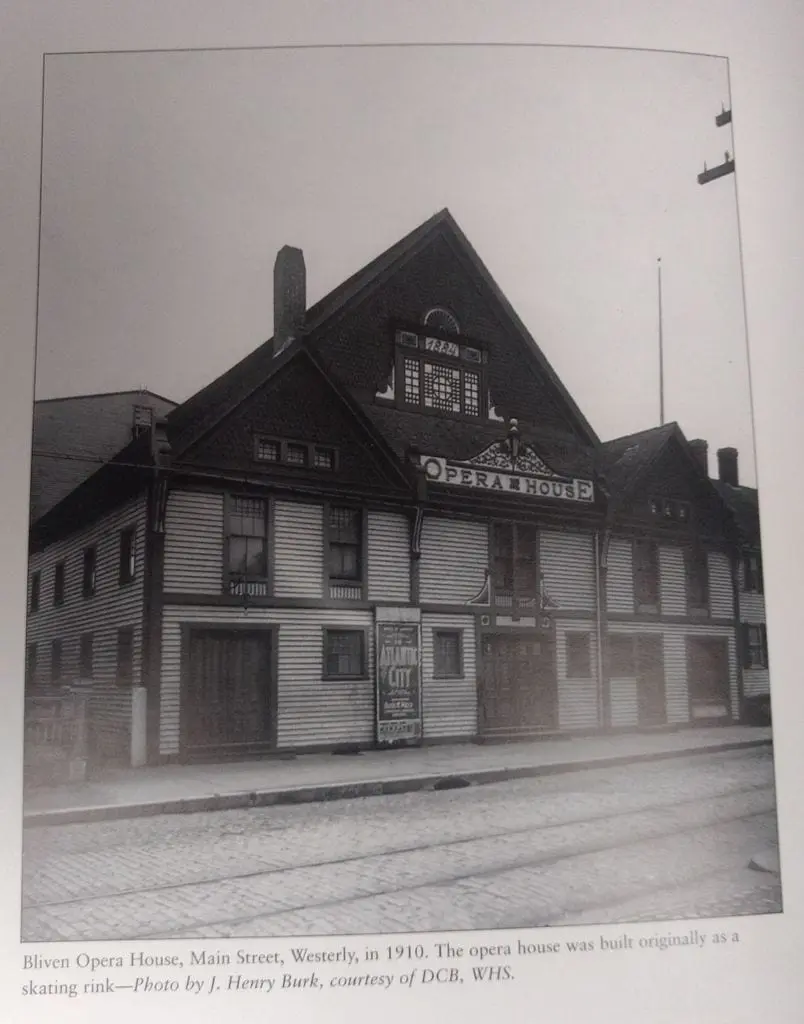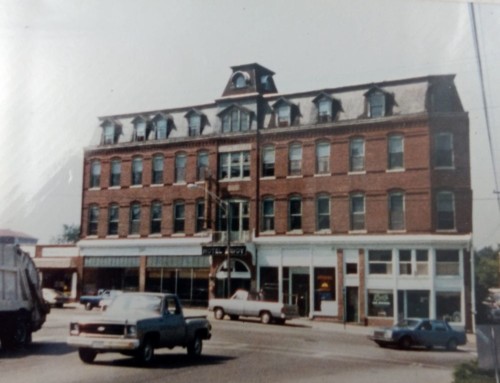In the 1880’s, decades before the days of digital media and home entertainment, and long before the rise of motion pictures, one of the most popular forms of recreation was live music and theater. From 1884 to 1925, Bliven’s Opera House served as the premier entertainment venue in Westerly, hosting a wide variety of performances throughout its history. Over the span of four decades and two buildings, from the original building’s construction in 1884, through a rebuild in 1904, and ending in tragedy as the result of a fire in January 1925, the opera house was one of Westerly’s most notable and popular sites.
Courtland Bradford Bliven was born in Westerly on March 16, 1851, to Bradford Bliven and his wife, Anna J. Barber.[1] C.B. Bliven, as he came to be known, was a prominent man in Westerly, engaging in a wide range of interests, including the fish business, the sewing machine business, and a financial stake in an insurance company.[2]
In 1884, he built the original opera house at what is now 98 Main Street, near the present site of Avie’s Ski and Sports and EZ Midway Liquors. The building came to be identified with its founder and was subsequently known as Bliven’s Opera House.[3] Originally, the opera house served as a skating rink and featured a number of prominent roller skaters, hosting the likes of Professor R.J. Aginton, known as “the Scientific Skater” in January 1885 and Miss Jennie Houghton “Champion Lady Skater” in February 1885. Tickets for these skating exhibitions cost 15 cents for general admission and 25 cents for reserved seats ($3.86 and $6.43 respectively in modern dollars).[4]
The first performance in what was billed as the “New Opera House,” however, was a concert by “the Famous Hungarian Band,” a full orchestra performing the “weird and fascinating music of Hungary” which was held on December 23, 1884.[5] Throughout 1885, the building played host to social hops, ice cream parties, and skating performances by ‘the midgets’ (children aged 6 to 8 years).[6]
On some occasions, shows were held specifically for the enjoyment of ladies and children.[7] In late 1885, the opera house was converted from a skating rink into a vaudeville house and performance stage.[8] After the conversion, performances by Edwin R. Lang’s Brilliant Comedy Company and Gorton’s Original New Orleans Minstrel Company were held.[9]
In 1886 and 1887, the Opera House also hosted ‘the People’s Lecture Course,’ a series of lectures on various topics.[10] Sporting events were also popular at the opera house, and it served as the setting for several polo games between the local crew and teams from around the state throughout the 1880’s and 1890’s.[11] While lectures, sporting events, and comedy shows were often featured at Bliven’s Opera House, the building was most frequently used as a space for musicians and opera singers. Throughout the last decade of the 19th-century, concerts were regularly held and widely attended at the site.[12]
In 1905, the C.B. Bliven Opera House Company was formed, and shortly thereafter, extensive improvements were made to the facilities.[13] The building, which held 1,200 patrons became a popular site for events which required larger accommodations, including the heavily attended memorial service of George H. Utter in December 1912 and the graduation ceremonies for Westerly High School.[14]
In the early 20th-century, films grew massively in popularity, and they became a frequent event at the opera house. In 1916, for example, a 20-minute film, “The Worst of Friends” was shown with tickets going for five and 10 cents for a matinee and 10 and 20 cents for evening shows.[15] At the height of the 1918 Flu Epidemic, the opera house became one of the many buildings to be closed in Westerly, when Frank Vennette, the building’s manager, made the decision to cancel planned films to prevent further spread of the sickness.[16]
In October 1919, the opera house was host to former baseball player turned nationally-renowned evangelist Billy Sunday, who delivered one of his impassioned anti-alcohol speeches, which drew large audiences across the country among the pro-temperance crowd.[17] In September 1924, David Novogrod purchased the opera house from the C.B. Bliven Opera House Company.[18] Novogrod’s tenure as owner of the building would be short-lived, however, as tragedy struck just months after the purchase.
Just after midnight on January 3, 1925, only hours after a vaudeville and motion picture show had come to an end, the Bliven Opera House was the scene of a devastating fire. At 12:30 a.m., Arthur Fraser of Main Street discovered the fire in the basement of the building and it was quickly determined that the blaze posed a significant threat to downtown Westerly if it was not immediately combatted.[19] The fire ignited several nearby homes, however, all but a few were saved.[20]
The magnitude of the inferno was considerable and was later considered to be the worst fire the town had seen to that point.[21] It was said that the flames reached as high as 85-feet in the air and the reflection of them on the sky could be seen up to 20 miles away.[22] Because of the sheer size of the disaster, eight fire companies were called in to assist in extinguishing the blaze which required all available fire hydrants in the area and 27 lines of fire hose. [23] Units arrived from Watch Hill, Stonington, Mystic and New London and they spent the next several hours battling the flames before finally being dismissed at four in the morning, three and a half hours after the fire was first reported.[24]
Once the fire was completely extinguished, the damage assessment could begin. At the south end of the building, a confectionery and fruit store had its plate glass windows blown out and suffered irreparable damage.[25] The Opera House itself was estimated by owner David Novogrod (who was in New York at the time of the disaster) to have suffered $60,000 worth of damage (nearly $875,000 in 2018), part of which would be covered by insurance.[26]
The group that had performed on the night before the fire, the Musical Spillers Act, lost several valuable instruments and incurred a loss of close to $2,000 ($29,000 today).[27] The damage done to the Bliven Opera House was considerable, and as a result, the building never reopened. Despite its unfortunate end, the Bliven Opera House had a significant impact on Westerly as it served as the town’s premier entertainment venue for more than forty years.
[su_accordion class=””] [su_spoiler title=”Footnotes” open=”no” style=”default” icon=”plus” anchor=”” class=””]
[1] Representative Men and Old Families of Rhode Island: Genealogical Records and Historical Sketches of Prominent and Representative Citizens and of Many of the Old Families, vol. III, (Chicago, IL, 1908), pg. 1627.
[2] Representative Men and Old Families of Rhode Island: Genealogical Records and Historical Sketches of Prominent and Representative Citizens and of Many of the Old Families, vol. III, (Chicago, IL, 1908), pg. 1627.
[3] “Fire Wipes Out Opera House, Two Tenement Buildings Lost, Four Families Are Homeless,” Westerly Sun, 4 January 1925.
[4] Bliven Opera House Collection, Westerly Historical Society.
[5] Bliven Opera House Collection, Westerly Historical Society.
[6] Bliven Opera House Collection, Westerly Historical Society.
[7] Bliven Opera House Collection, Westerly Historical Society.
[8] Ryan, George, Historic Photos of Westerly, Bliven’s Opera House-1920, http://www.georgeryan.com/blivens-opera-house-1920/.
[9] Bliven Opera House Collection, Westerly Historical Society.
[10] Bliven Opera House Collection, Westerly Historical Society.
[11] Bliven Opera House Collection, Westerly Historical Society.
[12] Bliven Opera House Collection, Westerly Historical Society.
[13] “Fire Wipes Out Opera House, Two Tenement Buildings Lost, Four Families Are Homeless,” Westerly Sun, 4 January 1925.
[14] O’Connell, Tom A., Westerly’s Gold, pg. 34.
[15] “Memorial Service in Honor of Hon. George H. Utter” The Sabbath Recorder, Volume 73, pg. 809.
[16] O’Connell, Tom A., In and About Westerly, pg. 142.
[17] O’Connell, Tom A., In and About Westerly, pg. 148.
[18] “Fire Wipes Out Opera House, Two Tenement Buildings Lost, Four Families Are Homeless,” Westerly Sun, 4 January 1925.
[19] “Fire Wipes Out Opera House, Two Tenement Buildings Lost, Four Families Are Homeless,” Westerly Sun, 4 January 1925.
[20] “Fire Wipes Out Opera House, Two Tenement Buildings Lost, Four Families Are Homeless,” Westerly Sun, 4 January 1925.
[21] “Fire Wipes Out Opera House, Two Tenement Buildings Lost, Four Families Are Homeless,” Westerly Sun, 4 January 1925.
[22] “Fire Wipes Out Opera House, Two Tenement Buildings Lost, Four Families Are Homeless,” Westerly Sun, 4 January 1925.
[23] “Fire Wipes Out Opera House, Two Tenement Buildings Lost, Four Families Are Homeless,” Westerly Sun, 4 January 1925.
[24] “Fire Wipes Out Opera House, Two Tenement Buildings Lost, Four Families Are Homeless,” Westerly Sun, 4 January 1925.
[25] “Fire Wipes Out Opera House, Two Tenement Buildings Lost, Four Families Are Homeless,” Westerly Sun, 4 January 1925.
[26] “Fire Wipes Out Opera House, Two Tenement Buildings Lost, Four Families Are Homeless,” Westerly Sun, 4 January 1925.
[27] “Fire Wipes Out Opera House, Two Tenement Buildings Lost, Four Families Are Homeless,” Westerly Sun, 4 January 1925.
[/su_spoiler] [/su_accordion]






